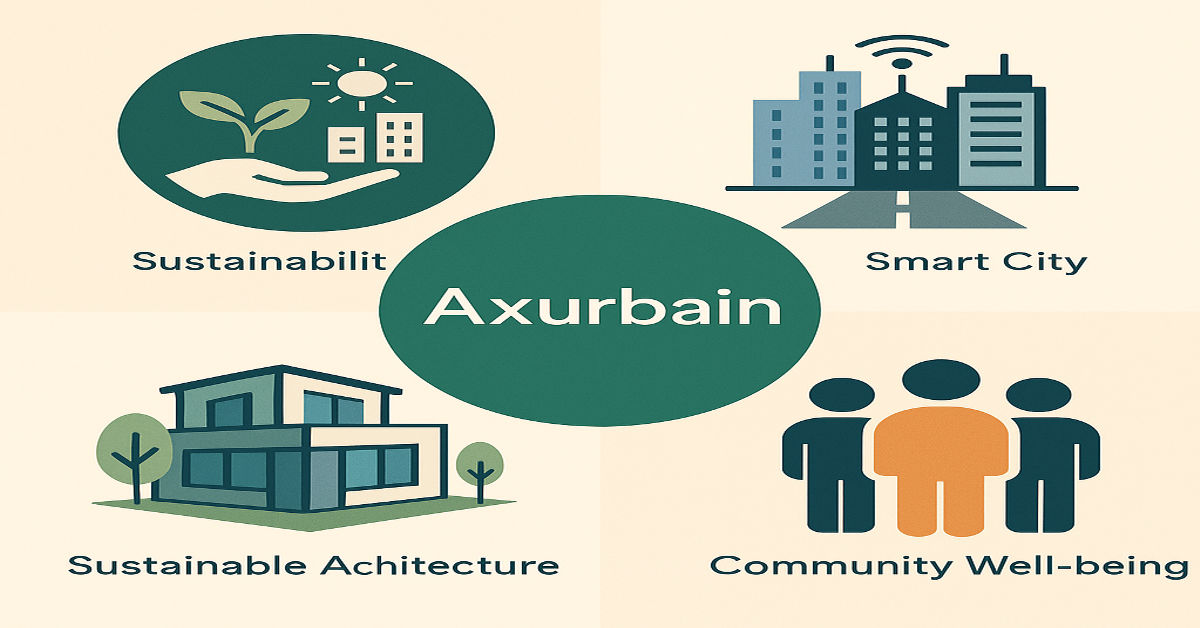
Cities are constantly evolving, reshaping themselves to accommodate population growth, technological innovations, and sustainability demands. The term Axurbain can be understood as an urban axis, a central idea that represents the convergence of infrastructure, architecture, mobility, and community well-being in the development of modern cities. Unlike traditional urban growth, which often expanded haphazardly, the Axurbain concept emphasizes planned evolution, smart infrastructure, ecological sensitivity, and balanced lifestyles.
This article provides a comprehensive exploration of Axurbain, considering it as both a philosophy of city development and a framework for sustainable urban design. We will examine its principles, challenges, benefits, and global relevance, while also presenting case studies, conceptual tables, and analytical insights that highlight why Axurbain could define the future of metropolitan life.
Understanding Axurbain
Defining the Concept
The word Axurbain suggests the idea of an axis around which cities grow and function. This axis is not just geographical, but also symbolic—it represents the intersection of transport, culture, economy, environment, and technology. It is a multi-dimensional vision that views cities as interconnected ecosystems rather than mere collections of buildings and streets.
The Five Pillars of Axurbain
- Sustainability: Ensuring growth is environmentally responsible.
- Mobility: Prioritizing smart, integrated, and eco-friendly transportation.
- Technology: Building digital cities powered by data and innovation.
- Community: Designing inclusive and people-centered urban spaces.
- Resilience: Preparing cities to adapt to climate change and economic shifts.
Historical Context of Urban Evolution
Cities have always grown around central axes—rivers, trade routes, or industrial hubs. Axurbain redefines this by making the axis more conscious and planned.
Early Urban Models
- Ancient cities centered around marketplaces and temples.
- Medieval towns grew around castles or defensive structures.
- Industrial-age cities were organized around factories and transport corridors.
Transition to Modern Planning
With globalization, urban sprawl became common. High-rise developments and mega-roads disconnected people from nature and created congestion. The Axurbain model proposes re-centering cities on balance and sustainability, reversing the disconnection.
Principles of Axurbain
Sustainable Architecture
Buildings under the Axur bain vision are energy-efficient, adaptive, and eco-integrated. Green rooftops, solar panels, and modular construction become standard.
Integrated Mobility
Rather than cars dominating, Axur bain prioritizes:
- Public transport (metros, trams, buses).
- Green mobility (cycling, walking).
- Smart vehicles (electric, shared, autonomous).
Technology as a Backbone
Cities designed with Axur bain principles leverage:
- IoT (Internet of Things) for traffic and energy management.
- AI-driven planning for efficient land use.
- Data ecosystems for real-time urban decision-making.
Human-Centered Spaces
Axur bain rejects car-centric models. Instead, it designs cities that emphasize:
- Parks and cultural spaces.
- Pedestrian-friendly neighborhoods.
- Inclusive facilities for all age groups and abilities.
The Axurbain Model: A Framework for Future Cities
| Dimension | Traditional City Model | Axurbain Model |
|---|---|---|
| Growth Axis | Roads, factories, and markets | Sustainability, people, and technology |
| Transportation | Car-dominated, fragmented | Integrated, green, multimodal |
| Architecture | Energy-intensive, concrete-based | Green, modular, sustainable |
| Community Planning | Exclusive, income-based zoning | Inclusive, mixed-use, people-first |
| Technology Role | Minimal, secondary to infrastructure | Central, guiding development decisions |
| Environmental Impact | High pollution and ecological footprint | Reduced carbon emissions, eco-restoration |
Challenges of Implementing Axurbain
Economic Constraints
Sustainable infrastructure requires large upfront investments, which not all cities can afford.
Policy and Governance
Strong governance and coordination are essential. Fragmented authorities can hinder integrated planning.
Social Inclusion
Ensuring low-income communities benefit equally from Axur bain projects is a challenge. Affordable housing and equitable access must be guaranteed.
Technology Risks
Over-reliance on digital systems may create privacy risks and cyber vulnerabilities. Balance between innovation and ethics is crucial.
Benefits of the Axurbain Approach
- Environmental Gains: Reduced pollution, greener landscapes, and biodiversity restoration.
- Health and Well-being: More walkable spaces, cleaner air, and mental health benefits.
- Economic Resilience: Cities attract investment, talent, and tourism by being future-ready.
- Social Harmony: Inclusive spaces reduce inequality and enhance cultural exchange.
- Future-Proofing: Cities become more resilient to climate change, disasters, and economic fluctuations.
Case Study Approach
European Cities as Examples
Cities like Copenhagen and Amsterdam embody parts of the Axur bain model through cycling networks and green energy.
Asian Adaptations
Singapore and Seoul showcase smart infrastructure and vertical greenery, integrating technology with ecology.
Potential in Developing Nations
For rapidly urbanizing countries, Axur bain offers a chance to leapfrog old models and build sustainable urban centers from scratch.
Role of Citizens in Axurbain
Citizens are not passive users but co-creators of urban spaces. Through participatory planning, digital apps, and community forums, people shape their city’s future.
Example of Citizen Participation
- Reporting air quality via mobile apps.
- Participating in local transport planning.
- Contributing to community green projects.
Axurbain and Global Sustainability Goals
The Axur bain concept aligns with the United Nations Sustainable Development Goals (SDGs):
- SDG 11: Sustainable Cities and Communities.
- SDG 13: Climate Action.
- SDG 7: Affordable and Clean Energy.
- SDG 3: Good Health and Well-being.
The Future of Axurbain
Looking forward, Axur bain represents the next chapter of urban evolution. By merging sustainability, technology, and inclusivity, it sets the foundation for cities of tomorrow. With climate change threatening coastal megacities, and population growth pushing infrastructure to the limits, adopting Axur bain is not just a choice but a necessity for survival and prosperity.
Conclusion
The concept of Axur bain captures the essence of future-ready urban development. It is more than just an idea of modern cities—it is a blueprint for living harmoniously within sustainable, inclusive, and technologically advanced ecosystems. As governments, architects, technologists, and citizens collaborate, Axur bain can transform how humanity builds and inhabits its spaces. While challenges exist, the benefits far outweigh the risks, making it a guiding philosophy for a world facing unprecedented urban challenges.
FAQs
Q1: What does the term Axurbain mean?
A: Axurbain refers to an “urban axis,” representing the balance of sustainability, mobility, technology, and community in city development.
Q2: How does Axurbain differ from traditional city planning?
A: Unlike traditional models that prioritize vehicles and industries, Axurbain centers cities around people, environment, and technology.
Q3: Can developing nations adopt Axurbain principles?
A: Yes, they can leapfrog outdated models and integrate sustainable infrastructure directly into their urban growth.
Q4: What role does technology play in Axurbain cities?
A: Technology underpins smart systems, from transport management to energy efficiency, ensuring efficiency and sustainability.
Q5: Why is Axurbain important for the future?
A: With rapid urbanization and climate change, Axurbain provides a framework for building resilient, sustainable, and inclusive cities.






